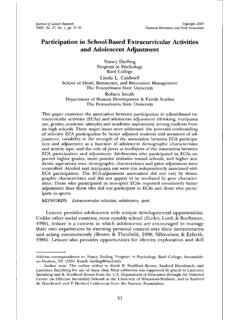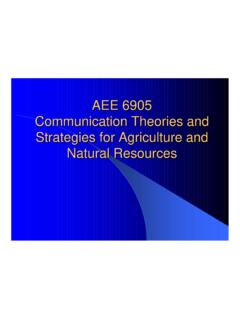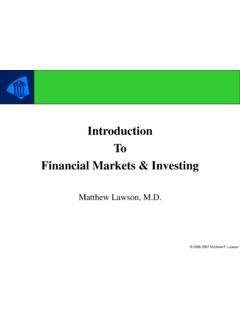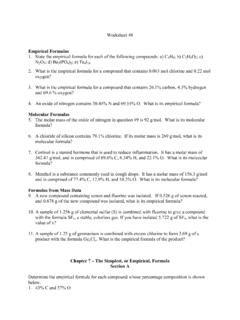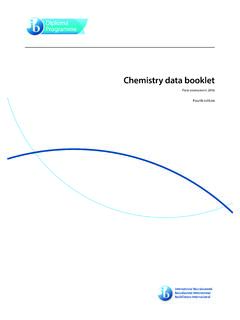Transcription of Forensic Science Timeline - University of Florida
1 The Forensic Science Timeline can also be found as an appendix in our recently published bookPrinciples and Practice of Forensic Science : The Profession of Forensic See also the Forensic Science This is a work in progress Please e-mail comments and ~ This work is copyright of Norah Rudin and Keith Inmanall rights are reservedIt may not be reprinted, distributed, or posted on any other web site without explicit you are viewing this page, or any facsimile of it on a domain other than , you are viewing pirated you would like to provide this content to the viewers of your web site, please feel free to link directly to this Science Timelineupdated 2/7/02 BCEE vidence of fingerprints in early paintings and rock carvings of prehistoric humans700sChinese used fingerprints to establish identity of documents and clay sculpture, but without any formal classificationsystem.
2 (1000)Quintilian, an attorney in the Roman courts, showed that bloody palm prints were meant to frame a blind man of hismother s Chinese book, Hsi Duan Yu (the washing away of wrongs), contains a description of how to distinguish drowningfrom strangulation. This was the first recorded application of medical knowledge to the solution of first treatise on systematic document examination was published by Fran ois Demelle of France1686 Marcello Malpighi, a professor of anatomy at the University of Bologna, noted fingerprint characteristics. However,he made no mention of their value as a tool for individual Lancaster, England, John Toms was convicted of murder on the basis of the torn edge of wad of newspaper in apistol matching a remaining piece in his pocket. This was one of the first documented uses of physical matching.
3 (1800s)Thomas Bewick, an English naturalist, used engravings of his own fingerprints to identify books he ne Fran ois Vidocq, in return for a suspension of arrest and a jail sentence, made a deal with the police toestablish the first detective force, the S ret of first recorded use of question document analysis occurred in Germany. A chemical test for a particular ink dyewas applied to a document known as the Konigin Orfila, a Spaniard who became professor of medicinal / Forensic chemistry at University of Paris, publishedTraite des Poisons Tires des Regnes Mineral, Vegetal et Animal, ou Toxicologie General l. Orfila is considered thefather of modern toxicology. He also made significant contributions to the development of tests for the presence ofblood in a Forensic context and is credited as the first to attempt the use of a microscope in the assessment of blood andsemen Evangelist Purkinji, a professorprofessor of anatomy at the University of Breslau, Czecheslovakia, publishedthe first paper on the nature of fingerprints and suggested a classification system based on nine major types.
4 However,he failed to recognize their individualizing Nichol invented the polarizing light microscope.(1830s)Adolphe Quetelet, a Belgian statistician, provided the foundation for Bertillon s work by stating his belief that no twohuman bodies were exactly first noted amylase activity in human Goddard, one of Scotland Yard s original Bow Street Runners, first used bullet comparison to catch amurderer. His comparison was based on a visible flaw in the bullet which was traced back to a Marsh, an Scottish chemist, was the first to use toxicology (arsenic detection) in a jury Bayard published the first reliable procedures for the microscopic detection of sperm. He also noted the differentmicroscopic characteristics of various different substrate Servais Stas, a chemistry professorprofessor from Brussels, Belgium, was the first successfully to identifyvegetable poisons in body Teichmann, in Kracow, Poland, developed the first microscopic crystal test for hemoglobin using English physician, Maddox, developed dry plate photography, eclipsing M.
5 Daguerre s wet plate on tin made practical the photographing of inmates for prison William Herschel, a British officer working for the Indian Civil service, began to use thumbprints on documentsboth as a substitute for written signatures for illiterates and to verify document Dutch scientist J. (Izaak) Van Deen developed a presumptive test for blood using guaiac, a West Indian German scientist Sch nbein first discovered the ability of hemoglobin to oxidize hydrogen peroxide making itfoam. This resulted in first presumptive test for first advocated the use of photography for the identification of criminals and the documentation ofevidence and crime Taylor, microscopist to Department of Agriculture suggested that markings of the palms of the handsand the tips of the fingers could be used for identification in criminal cases.
6 Although reported in the AmericanJournal of Microscopy and Popular Science and Scientific American, the idea was apparently never pursued from Virchow, a German pathologist, was one of the first to both study hair and recognize its Faulds, a Scottish physician working in Tokyo, published a paper in the journal Nature suggesting thatfingerprints at the scene of a crime could identify the offender. In one of the first recorded uses of fingerprints to solvea crime, Faulds used fingerprints to eliminate an innocent suspect and indicate a perpetrator in a Tokyo Thompson, a railroad builder with the Geological Survey in New Mexico, put his own thumbprint onwage chits to safeguard himself from Bertillon, a French police employee, identified the first recidivist based on his invention of Conan Doyle published the first Sherlock Holmes story in Beeton s Christmas Annual of Alexandre Lacassagne, professorprofessor of Forensic medicine at the University of Lyons, France, was the first totry to individualize bullets to a gun barrel.
7 His comparisons at the time were based simply on the number of lands Gross, examining magistrate and professor of criminal law at the University of Graz, Austria, publishedCriminal Investigation, the first comprehensive description of uses of physical evidence in solving crime. Gross is alsosometimes credited with coining the word (Sir) Francis Galton published Fingerprints, the first comprehensive book on the nature of fingerprints and their usein solving Vucetich, an Argentinean police researcher, developed the fingerprint classification system that would come tobe used in Latin America. After Vucetich implicated a mother in the murder of her own children using her bloodyfingerprints, Argentina was the first country to replace anthropometry with Dreyfus of France was convicted of treason based on a mistaken handwriting identification by Edward Richard Henry developed the print classification system that would come to be used in Europe andNorth America.
8 He published Classification and Uses of Finger Jesrich, a Forensic chemist working in Berlin, Germany, took photomicrographs of two bullets to compare, andsubsequently individualize, the Uhlenhuth, a German immunologist, developed the precipiten test for species. He was also one of the first toinstitute standards, controls, and QA/QC procedures. Wassermann (famous for developing a test for syphilis) andSch tze independently discovered and published the precipiten test, but never received due Landsteiner first discovered human blood groups and was awarded the Nobel prize for his work in 1930. MaxRichter adapted the technique to type stains. This is one of the first instances of performing validation experimentsspecifically to adapt a method for Forensic Science . Landsteiner's continued work on the detection of blood, itsspecies, and its type formed the basis of practically all subsequent Edward Richard Henry was appointed head of Scotland Yard and forced the adoption of fingerprintidentification to replace P.
9 DeForrest pioneered the first systematic use of fingerprints in the United States by the New York CivilService Reiss, professor at the University of Lausanne, Switzerland, and a pupil of Bertillon, set up one of thefirst academic curricula in Forensic Science . His Forensic photography department grew into Lausanne Institute ofPolice New York State Prison system began the first systematic use of fingerprints in United States for At Leavenworth Federal Penitentiary, Kansas, Will West, a new inmate, was initially confused with a resident convictWilliam West using anthropometry. They were later (1905) found to be easily differentiated by their fingerprints. For ahistorical clarification, please see 1904 Oskar and Rudolf Adler developed a presumptive test for blood based on benzidine, a new chemical developed President Theodore Roosevelt established Federal Bureau of Investigation (FBI).
10 1910 Victor Balthazard, professor of Forensic medicine at the Sorbonne, with Marcelle Lambert, published the firstcomprehensive hair study, Le poil de l'homme et des animaux. In one of the first cases involving hairs, RosellaRousseau was convinced to confess to murder of Germaine Bichon. Balthazard also used photographic enlargementsof bullets and cartridge cases to determining weapon type and was among the first to attempt to individualize a bulletto a Locard, successor to Lacassagne as professor of Forensic medicine at the University of Lyons, France,established the first police crime S. Osborne, an American and arguably the most influential document examiner, published Takayama developed another microscopic crystal test for hemoglobin using hemochromogen Balthazard, professor of Forensic medicine at the Sorbonne, published the first article on individualizing Lattes, professor at the Institute of Forensic Medicine in Turin Italy, developed the first antibody test for ABOblood groups.
